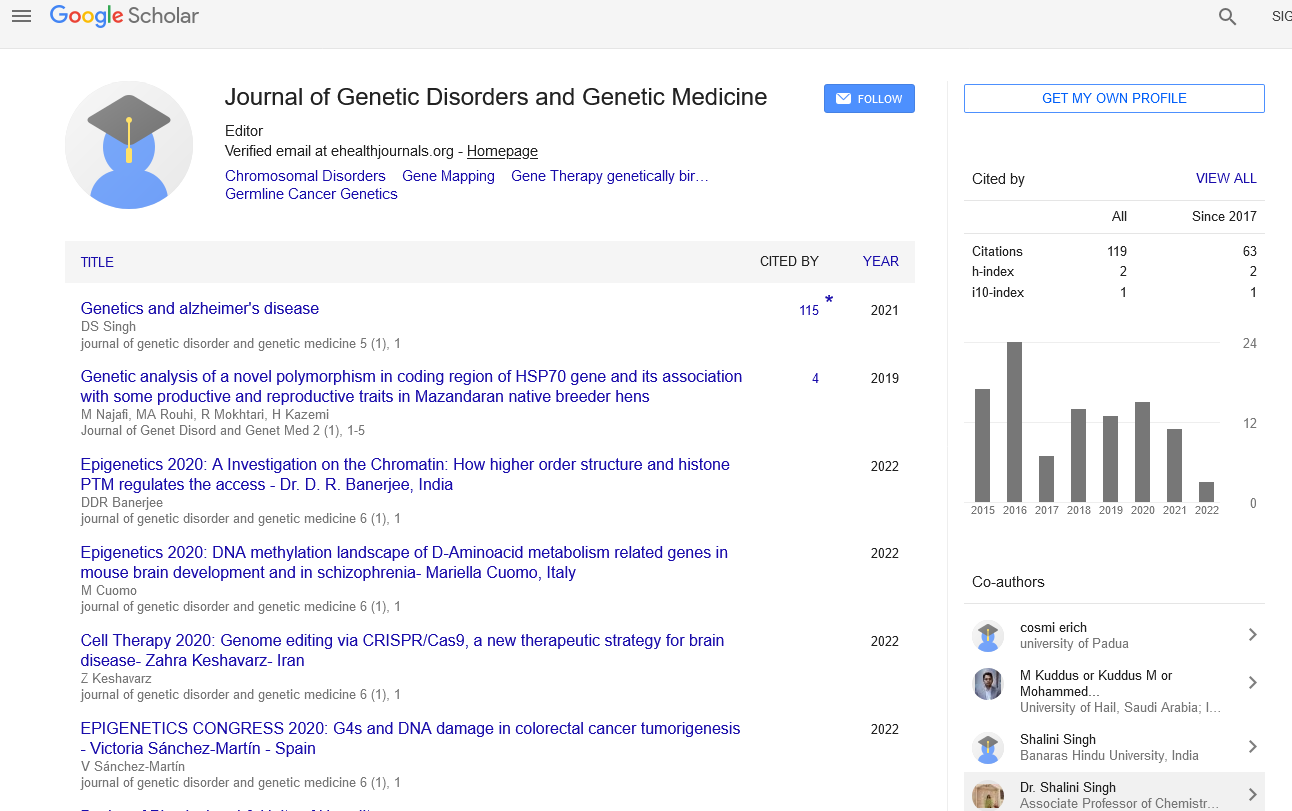Environmental interactions and individual pharmaco genetics
Received: 18-Feb-2022, Manuscript No. PULJGDGM-22-3924; Editor assigned: 21-Feb-2022, Pre QC No. PULJGDGM-22-3924(PQ); Reviewed: 07-Mar-2022 QC No. PULJGDGM-22-3924; Revised: 11-Mar-2022, Manuscript No. PULJGDGM-22-3924(R); Published: 18-Mar-2022
Citation: Kate W. Environmental interactions and Individual pharmaco genetics. J Genet Disord Genet Med. 2022;6(1):1.
This open-access article is distributed under the terms of the Creative Commons Attribution Non-Commercial License (CC BY-NC) (http://creativecommons.org/licenses/by-nc/4.0/), which permits reuse, distribution and reproduction of the article, provided that the original work is properly cited and the reuse is restricted to noncommercial purposes. For commercial reuse, contact reprints@pulsus.com
Abstract
Genetics deals with genes, genetic variation, gene mutation and heredity with a heavy focus on inborn. Genetics is important because many of the diseases have their tuber in polymorphisms or mutations in gene. Molecular biology allows the study of gene functions, polymorphisms and mutations. Molecular Biology is difficulty coil. This field of biological sciences is a rapidly growing field which has a host of important applications not only in in biomedical sciences, but also in other areas.
Keywords
Genetics; Gene mutation; Polymorphisms
Introduction
Genomics is worried with the investigation of human nucleic acids as they relate to disease. It is closely tied to molecular that code of genes for proteins and cell biology Thus, it is through the analysis of genes that insight into the genesis of protein malfunction can be achieved. Such examination specifically entails an assessment of how the DNA sequence of a gene compares with its normal sequence or wild-type. Ultimately, malfunctions of protein related to gene mutations lead to organ dysfunction and disease states. This chapter reviews the fundamentals of molecular genetics and the concepts inborn to molecular genetics. It discusses the molecular structure of DNA, protein translation, DNA transcription, DNA replication, molecular pathology and DNA repair mechanisms. It also provides a basic overview of transmission genetics and highlights the relationship between proteins, genes and phenotype and includes rationale for molecular genetic testing. Applied research in genetics has produced many benefits, including the recognition of the molecular basis of cancer and human genetic disorders. For example, many genetic diseases have been discovered as a result of a single mutation or a specific chromosomal rearrangement and are understood at the molecular level, including, but not limited to, hemophilia, sickle-cell anemia, Duchenne muscular dystrophy, cystic fibrosis Down syndrome, Li-Fraumeni syndrome, Tay-Sachs disease, Prader-Willi syndrome, Wilm's tumor, Angelman's syndrome, and many metabolic disorders. The fields of environmental genomics and environmental genetics has huge potential to affect our ability to accurately assess the risk of disease developing, identify and understand basic pathogenic mechanisms. Synergetic approaches that team together environmental scientists with molecular geneticists, biologists physician scientists and physiologists are critical to the investigation of environmental aspects of human health. Utilize eukaryotic model systems zebrafish, yeast, Drosophila rodents and Caenorhabditis elegans, will accelerate our understanding of exposures of environmental on human health. Despite the eneromous inter-individual variance in the response to environmental toxicants, we simply do not understand why certain people develop disease when challenged with environmental agents, and others remain healthy.
Conclusion
Although an appeal of concurrence suggests that many of the complex and prevalent diseases that humans develop occur as a result of biologically multiple unique gene environment interactions and gene to gene, this theoretical framework is limited. In fact, the development of disease in humans, environmental is complex. Environmental exposures affect those that are exposed temporally and by unique nutritional status, co-morbid disease, genetics and economic status. Even this prototype fails to the complex interaction of exogenous risks and endogenous that ultimately interacts to cause disease. Recent advances in human and molecular genetics provide a no match opportunity to understand how genetic and genes changes interact with environmental stimuli to either preserve health or cause disease. Understanding the complex relationship between endogenous and exogenous risks in populations and within affected individuals is precisely the opportunity and challenge that face scientists involved in environmental genetics and genomics.





